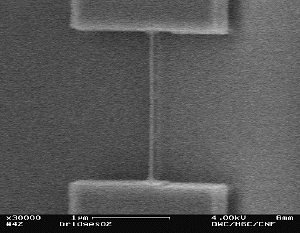 | ||
Gibson flying v world smallest guitar nano guitar
Dustin W. Carr, under the direction of Professor Harold G. Craighead, created the nano guitar in the Cornell Nanofabrication Facility in 1997. The idea came about as a fun way to illustrate nanotechnology, and it did capture popular attention. It is disputed as to whether the nano guitar should be classified as a guitar, but it is the common opinion that it is in fact a guitar.
Nanotechnology miniaturizes normal objects, in this case a guitar. It can be used to create tiny cameras, scales and listening devices. An example of this is smart dust, which can be either a camera or a listening device smaller than a grain of sand. A nanometer is one-billionth of a meter. For comparison, a human hair is about 200,000 nanometers thick. The nano guitar is about as long as one-twentieth of the diameter of a human hair, 10 micrometers or 10,000 nanometers long. The six strings are 50 nanometers wide each. The entire guitar is the size of an average red blood cell. The guitar is carved from a grain of crystalline silicon by scanning a laser over a film called a 'resist'. This technique is called Electrobeam Lithography. It can be played by tiny lasers in an atomic force microscope, and these act as the pick. The Nano Guitar is 17 octaves higher than a normal guitar. Even if its sound were amplified, it could not be detected by the human ear.
The nano guitar illustrates inaudible technology that is not meant for musical entertainment. The application of frequencies generated by nano-objects is called sonification. Such objects can represent numerical data and provide support for information processing activities of many different kinds that producing synthetic non-verbal sounds. Since the manufacture of the nano-guitar, researchers in the lab headed by Dr. Craighead have built even tinier devices. One thought is that they may be useful as tiny scales to measure tinier particles, such as bacteria, which may aid in diagnosis. More recently, physicists at the University of Washington published an article discussing the hope that the technique will be useful to test aspects of what until now has been purely theoretical physics, and they also hope it might have practical applications for sensing conditions at atomic and molecular scales.
